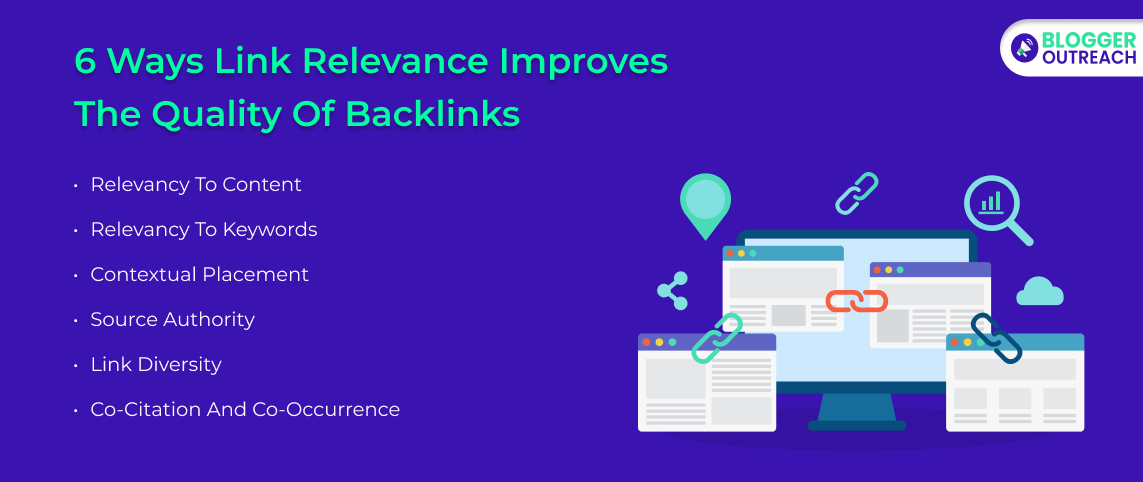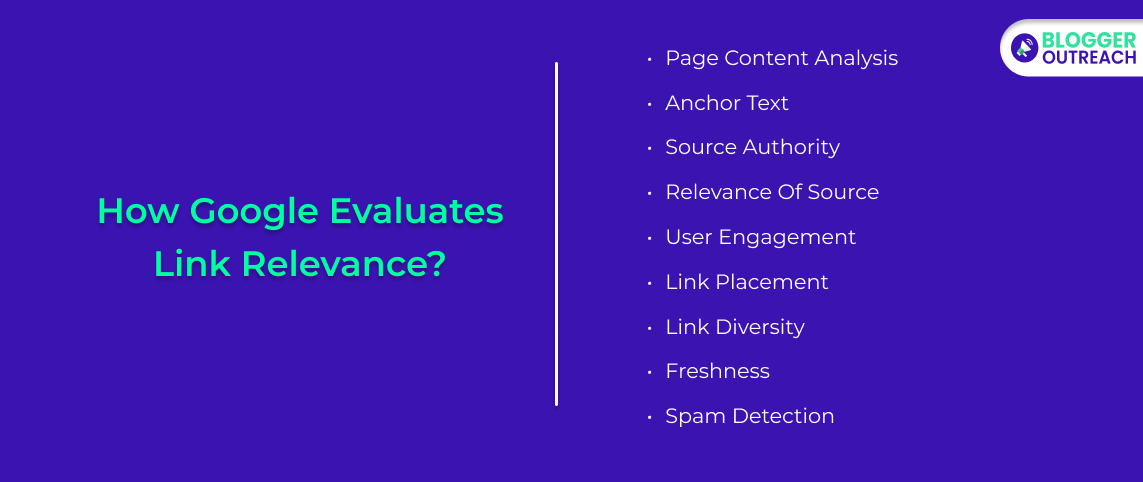Table Of Content
Google is strictly against manipulative link exchange.
In fact, the search giant condemns, “Link to me and I’ll link to you.” – So don’t do it for the sake of building links.
In fact, any link that manipulates the search engine algorithm is considered link spam. So, always be mindful.
Instead, your goal should be to add value. This is where link relevance gets the first priority. Even a high authority link becomes valueless if it comes from an irrelevant site.
So, what is link relevance? Why does it hold so much significance when it comes to backlinks?
We know that many questions are troubling you.
But no need to worry.
In This Article, We Will Explain:
- Link relevance.
- 5 Categories of link relevance.
- 6 ways to link relevance impacts the quality of backlinks.
- How Google perceives link relevance.
- Key factors that determine the quality of backlinks.
- How to check whether a link is relevant or not?
- Secrets to build relevant links.
So, let’s jump into the valuable information. Here you go:
What Is Link Relevance?

Link relevance, crucial in SEO, gauges how closely a backlink aligns with website content. Google values this, impacting search rankings significantly.
In backlink building, prioritizing relevance means connecting with websites in your niche. Collaborate with industry-specific partners and create content aligning with your focus.
Why is this crucial? Because link relevance surpasses quantity. It’s not just about how many backlinks you have; it’s about the quality and relevance of those links.
For example, building relevant links involves connecting with other SEO-related sites. For instance, collaborating with reputable SEO agencies, sharing insights with SEO communities, or guest posting on SEO-focused blogs aligns with the niche.
In-depth content on SEO strategies, algorithm updates, or case studies can attract links from similar blogs, strengthening relevance. Consistently curating valuable, niche-specific content positions you as an authoritative resource. In turn, it attracts relevant backlinks.
5 Categories Of Link Relevance
Let’s dig deeper into link relevance. Basically, link relevance can be segregated into 5 categories.
Knowing these categories will help you better understand what to build and what not:
Link relevance, crucial in link building, navigates a balance between quality and quantity. There are five categories of link relevance, each holding distinct characteristics.
First Category: Most Relevant
This category is super relevant but less scalable. It includes links from direct or indirect competitors, pay-to-play sites, nofollowed sites, and unscalable sites. Despite its limitations, these links showcase the highest relevance.
Second Category: Highly Relevant and Scalable
The next category strikes a balance. It’s topically or thematically relevant and scalable. Furthermore, it is often viewed as a “selective” link due to its high relevance.
Third Category: Audience-Relevant
Crucial for quantity in link building, these links may not be topically relevant but cater to the audience. Examples include mid-to-high DR ranges, sites with consistent traffic, and known brands in the niche.
Fourth Category: Scalable but Less Relevant
These links are highly scalable but less relevant. Identified by lower DR ranges, paid-for links, and potentially gray tactics, they serve a purpose in quantity but may lack direct relevance.
Fifth Category: Low Quality and Risky
Including spam sites, videos, DR <20, no traffic sites, and PBNs, these links are low quality and risky. Ignored or penalized, they lack relevance and are unlikely to attract genuine buyers.
If you want to know these 5 categories in detail, read this article.
6 Ways Link Relevance Improves The Quality Of Backlinks

Relevant links act like recommendations. Therefore, link relevance stands out as the utmost crucial factor in effective backlink building.
It’s about aligning content, keywords, and context with trusted sources. This not only enhances SEO but also establishes your site as credible.
1. Relevancy To Content: Backlinks from sites closely tied to your content hold more value. Google prioritizes relevance, making a tech blog link more valuable than one from a cooking blog.
2. Relevancy To Keywords: Anchor text backlinks with relevant keywords to provide an SEO boost. Aligning anchor text with target keywords aids search engines in understanding link context.
3. Contextual Placement: Backlinks embedded within article bodies surpass sidebar or footer links. Contextual links suggest editorial choice, elevating trust and relevance.
4. Source Authority: Link quality ties to the linking site’s authority. A link from a high-authority, niche-relevant source outweighs a link from a low-quality site.
5. Link Diversity: A varied link profile from sources like articles, blogs, and social media adds context. Diverse links indicate content trust and respect in multiple online communities.
6. Co-Citation And Co-Occurrence: Mentions alongside authoritative sources enhance relevance and authority signals. Co-citation and co-occurrence strengthen your website’s niche standing.
In essence, link relevance extends beyond mere connections.
Google Loves Link Relevance
One good link outperforms millions of low quality links!
Google’s very own John Mueller made the statement on Google Search Central SEO hangout.
in fact, According to Mueller, Webmasters and site owners shouldn’t focus on the overall number of links pointing to their site.
“I don’t think we differentiate like that in our systems. From my point of view, I would tend not to focus on the total number of links to your site or the total number of domain links to your website, because we look at links in a very different way.
We try to understand what is relevant for a website, how much we should weigh these individual links, and the total number of links doesn’t matter at all. Because you could go off and create millions of links across millions of websites if you wanted to, and we could just ignore them all.
So, from the above statement, it is apparent that link relevancy should be your number one priority.
How Google Evaluates Link Relevance?

Google employs a nuanced and diverse process to determine link relevance. Certainly, they assess the connections between pages.
1. Page Content Analysis
Google meticulously analyzes the content surrounding a link, aiming to grasp the context in which the link exists. This involves assessing the textual and visual elements on the linking page. Thus, it ensures that the link aligns seamlessly with the overall theme and subject matter.
2. Anchor Text
The anchor text, the clickable text of a hyperlink, is a crucial element in link relevance. Google evaluates this text to gain insights into the content of the linked page. A well-crafted and contextually relevant anchor text strengthens the association between the linked and linking content.
3. Source Authority
The authority and credibility of the linking page significantly impact link relevance. Google values links from pages with established authority in their respective domains. Higher-authority sources contribute more positively to the perceived relevance of the link.
4. Relevance Of Source
Beyond authority, Google assesses how closely the linking site relates to the topic of the linked page. A link from a source that shares thematic relevance enhances the overall contextual significance, indicating a more meaningful connection.
5. User Engagement
User behaviour provides valuable signals. Metrics like click-through rates contribute to Google’s understanding of a link’s importance. Links that attract user engagement are considered more relevant, as they serve the users’ interests and needs.
6. Link Placement
Context is paramount in link placement. Google takes into account where the link is positioned within the content. Links placed naturally within the body of an article are often viewed as more editorially chosen, enhancing the link’s trustworthiness and relevance.
7. Link Diversity
Google values diversity in link sources. Various domains refer to the content, which reinforces its relevance across contexts.
8. Freshness
The recency of information is a key factor in link relevance. In order to provide users with the most relevant and up-to-date information, Google considers how up-to-date the linked content is.
9. Spam Detection
Google employs sophisticated algorithms to detect and filter out manipulative or irrelevant links. This ensures that the link ecosystem maintains a high level of quality, emphasizing relevance and authenticity.
How To Check If A Link Is Relevant Or Not?
For the purpose of checking link relevancy, it is important that you know different approaches. In this case, it’s all about leveraging the best tools.
Unquestionably, Ahrefs and Semrush are the best.
Checking Link Relevance With Ahrefs
- Site Explorer:
Enter the website’s URL in “Site Explorer” for an overview, including domain rating and backlinks. - Backlink Profile:
Navigate to “Backlink profile” > “Referring domains” to analyze linked sites. Industry-related domains signal relevance. - Top Pages:
Access “Organic search” > “Top Pages” to explore the website’s high-performing content, revealing its thematic focus. - Content Gap Analysis:
Utilize “Content Gap” under “Site Explorer > Organic search” to compare keyword rankings. Similarities indicate potential relevance. - Anchor Text:
Visit “Site Explorer > Backlink profile > Anchors” to inspect anchor text. This unveils the site’s covered topics.
Checking Link Relevance With Semrush
- Domain Overview:
Input the website’s URL in “Domain Overview” for SEO metrics, offering insight into the site’s overall theme. - Backlink Analytics:
Explore the site’s backlink profile in “Backlink Analytics” > “Referring Domains.” Industry-related domains signify potential relevance. - Top Organic Pages:
Visit “Organic Research” > “Pages” to uncover top pages, aiding in understanding the site’s thematic relevance. - Keyword Gap:
Use the “Keyword Gap” tool to compare common keywords between your site and the potential backlink. Overlapping keywords suggest relevance. - Anchor Text:
In “Backlink Analytics,” check the “Anchor Text” section to understand the context of backlinks. This provides insights into the site’s content relevance.
In-depth link relevance assessment involves exploring domain metrics, backlink profiles, top pages, keyword alignments, and anchor text. This comprehensive analysis ensures strategic link building for SEO success.
Top Secrets To Building High Quality Backlinks
Building relevant backlinks is crucial for SEO success. Following best practices ensures link relevance.
Things To Do
✅Outreach To Relevant Sites
Connect with authoritative sites in your industry for high-quality backlinks. Personalized outreach builds connections and increases relevance.
✅Create Helpful Content
Craft value-added content solving user problems. Google prioritizes helpful content, attracting relevant backlinks.
✅Use The Right Anchor Text
Optimize anchor text for context. Relevant anchor text enhances user understanding and SEO value.
✅Leverage Social Media
Promote content on platforms like Twitter and LinkedIn. Informative, link-worthy content attracts natural backlinks.
Things To Avoid
❌Avoid Link Schemes
Why: Link schemes, such as bulk link building from low-quality sites, are viewed as manipulative by search engines and can lead to penalties.
How: Steer clear of tactics that involve acquiring many links quickly or from questionable sources. Focus on building links naturally over time.
❌Over-Optimization Of Anchor Text
Why: Keyword stuffing and over-optimization of anchor text can negatively impact the natural flow of content and appear spammy.
How: Use anchor text that is contextually relevant to the linked page. Avoid excessive use of exact-match keywords and ensure a diverse and natural anchor text distribution.
❌Quality And Relevance Matter
Why: Backlinks from low-quality or irrelevant domains can harm your website’s overall SEO.
How: Prioritize link quality over quantity. Ensure that links come from reputable and contextually relevant domains within your industry.
How To Monitor Relevant Backlinks
- Track And Analyze Metrics:
Use Ahrefs and Semrush to monitor referring domains, domain authority, anchor text, and backlink traffic regularly. - Disavow Irrelevant Backlinks:
Conduct a backlink audit using Google Search Console. Disavow irrelevant or spammy backlinks to protect your SEO. - Competitor Analysis:
Monitor competitors’ link profiles to identify link-building opportunities. Reach out to sites linking to competitors for mutual benefits.
Monitoring Relevant Backlinks:
- Track And Analyze Metrics:
- Why: Regularly monitoring backlink metrics helps assess the health and relevance of your link profile.
- How: Utilize tools like Ahrefs and Semrush to track referring domains, domain authority, anchor text distribution, and traffic generated from backlinks.
- Disavow Irrelevant Backlinks:
- Why: Irrelevant or spammy backlinks can negatively impact your SEO efforts and rankings.
- How: Conduct periodic backlink audits using tools like Google Search Console. Identify and disavow irrelevant or low-quality backlinks to maintain a healthy link profile.
- Competitor Analysis:
- Why: Analyzing competitors’ link profiles provides insights into potential link-building opportunities.
- How: Identify sites that link to your competitors but not to your site. Reach out to these sites, emphasizing the value you can provide and proposing a mutually beneficial link exchange.
Final Takeaway
Evidently, the secret sauce to backlinks is link relevance. Do you agree?
Well, let’s do a quick recap.
We have already talked about the important aspects of link relevance. Starting from Google’s point of view to best practices – you have to bring these strategies into action.
So, what’s your favourite strategy to build relevant backlinks?
Read Also:








